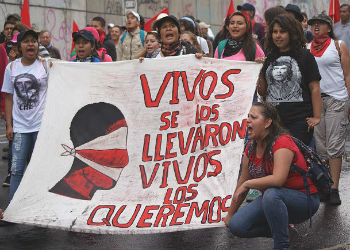September 26 marked the one year anniversary of the abduction of 43 students near Iguala, Mexico. The event remains a defining moment of the Enrique Peña Nieto presidency, although the full truth of what happened to the students that night remains unknown.
On the night of September 26, 2014, protesting students from a teachers college near Iguala, a town in the southwest state of Guerrero, were stopped by local police and handed over to criminal group the Guerreros Unidos, according to government investigators. The Guerreros Unidos allegedly proceeded to shoot and kill the students in a trash dump, then burned the remains and threw them in a river (See InSight Crime’s timeline below for a full recap of the missing students case).
The case of the missing 43 students quickly gained international attention. The Mexican government deployed over 4,000 federal police and soldiers to Guerrero to search for the students. Investigators believed they had achieved a breakthrough when an alleged leader of the Guerreros Unidos was captured in mid-October. The following month, police captured the fugitive mayor of Iguala and his wife, who was later identified by authorities as a leader of the Guerreros Unidos. In December, authorities said they had identified the remains of one of the missing students.
However, when authorities presented the conclusions of their investigation in January, they were met with widespread skepticism.
Numerous observers have since poked holes in the official version of events. Foreign forensic teams have cast doubt on the possibility that the students were burned at the trash dump (Mexican researchers had previously suggested the bodies were burned at an army crematorium). Just this month, a report commissioned by the Inter-American Commission on Human Rights (IACHR) offered several reasons why the government’s version of what happened could not have taken place.
InSight Crime Analysis
One of the main impacts of the Iguala case was the shattering of President Enrique Peña Nieto’s carefully-crafted image that Mexico had turned the corner in the fight against organized crime. The shocking details of the case were a reminder of how much corruption exists within Mexico’s local government.
At the same time, the case symbolized how the nature of Mexican organized crime has changed. The downfall of monolithic drug cartels has given rise to smaller criminal outfits dominating Mexico’s underworld. In many ways, the Guerreros Unidos — a splinter cell of the once-powerful Beltran Leyva Organization — embodies how these smaller gangs remain the primary threat to Mexico’s security, especially in rural areas where the gangs often work hand-in-hand with municipal authorities.
SEE ALSO: Guerreros Unidos Profile
The Iguala investigation also became a referendum of sorts on the credibility of the Mexican government, which drained away as more domestic and international observers became increasingly critical of the investigation. Despite several indications that security as a whole is improving in Mexico, the Iguala case remains a turning point for the Peña Nieto administration: afterwards, no one could deny how badly Mexico needs better police and more competent investigators. Meanwhile, the embarrassing escape of the world’s most notorious drug lord, Joaquin “El Chapo” Guzman from a Mexican prison in July further eroded trust in the Mexican government.
As for the victims, the government has only identified the remains of two students, with little indication that authorities are close to finding the others. The Peña Nieto government continues to insist that they are committing to finding “truth and justice” for the case, and has taken a series of notable actions since the release of the IACHR report in early September. These include the Attorney General’s Office making the case open to the public for the first time; the arrest of another key criminal suspect involved in the event; and keeping other students in a witness protection program.
However, one year on, the likelihood that the truth will ever emerge about what happened that night in Iguala appears to be slimmer than ever.

